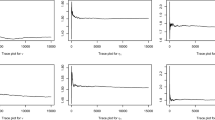Abstract
In engineering applications, probabilistic reliability theory appears to be presently the most important method, however, in many cases precise probabilistic reliability theory cannot be considered as adequate and credible model of the real state of actual affairs. In this paper, we developed a hybrid of probabilistic and non-probabilistic reliability theory, which describes the structural uncertain parameters as interval variables when statistical data are found insufficient. By using the interval analysis, a new method for calculating the interval of the structural reliability as well as the reliability index is introduced in this paper, and the traditional probabilistic theory is incorporated with the interval analysis. Moreover, the new method preserves the useful part of the traditional probabilistic reliability theory, but removes the restriction of its strict requirement on data acquisition. Example is presented to demonstrate the feasibility and validity of the proposed theory.
Similar content being viewed by others
References
Gardoni P., Der Kiureghian A. and Mosalam K.M. (2002). Probabilistic capacity models and fragility estimates for reinforced concrete columns based on experimental observations. J. Eng. Mech. ASCE 128: 1024–1038
Bulgakov B.V. (1990). Fehleranhaeufung bei Kreiselapparafeb (in German). Ing. Arch. 11: 461–469
Bulgakov B.V. (1996). On the accumulation of disturbances in linear systems with constant coefficients (in Russian). Dokl. Akad. Nauch SSSR LI(5): 339–342
Drenick, R.F.: Functional analysis of effects of earthquakes. In: 2nd Joint United States–Japan Semminar on Applied Stochastics, Washington DC, 19–29 September (1968)
Drenick R.F. (1970). Model-free design of a seismic structures. J. Eng. Mech. Div. 96(EM4): 483–493
Schweppe F.C. (1973). Uncertain Dynamics Systems. Prentice-Hall, Englewood Cliffs
Chernousko F.L. (1994). State Estimation of Dynamic Systems. CRC Press, Boca Raton
Ben-Haim Y. and Elishakoff I. (1990). Convex Models of Uncertainty in Applied Mechanics. Elsevier, Amsterdam
Ben-Haim Y. (1996). Robust Reliability in the Mechanical Sciences. Springer, Berlin
Ben-Haim Y. (2001). Information-Gap Decision Theory: Decisions under Severe Uncertainty. Academic, San Diego
Elishakoff I., Lin Y.K. and Zhu L.P. (1994). Probabilistic and Convex Modeling of Acoustically Excited Structures. Elsevier, Amsterdam
Elishakoff I., Li Y.W. and Starnes J.H. Jr. (2001). Non-Classical Problems in the Theory of Elastic Stability. Cambridge University Press, London
Qiu Z.P. and Wang X.J. (2003). Comparison of dynamic response of structures with uncertain-but-bounded parameters using non- probabilistic interval analysis method and probabilistic approach. Int. J. Solids Struct. 40: 5423–5439
Qiu Z.P. (2003). Comparison of static response of structures using convex models and interval analysis method. Int. J. Numer. Methods Eng. 56: 1735–1753
Qiu Z.P. and Elishakoff I. (2001). Anti-optimization technique a generalization of interval analysis for non-probabilistic treatment of uncertainty. Chaos Solitions Fractals 12: 1747–1759
Qiu Z.P. and Wang X.J. (2006). Interval analysis method and convex models for impulsive response of structures with uncertain- but-bounded external loads. Acta Mech. Sin. 22(3): 265–276
Mullen R.L. and Muhanna R.L. (1999). Bounds of structural response for all possible loading combinations. Struct. Eng. ASCE 125: 98–106
Rao S.S. and Berke L. (1997). Analysis of uncertain structural systems using interval analysis. AIAA J. 35: 727–735
Moore R.E. (1979). Methods and Applications of Interval Analysis. Prentice-Hall, London
Alefeld G. and Herzberger J. (1983). Introductions to Interval Computations. Academic, New York
Elishakoff I. (1983). Probabilistic Theory of Structures. Wiley, London
Thoft-Christensen P. and Baker M.J. (1982). Structural Reliability Theory and Its Applications. Springer, Heidelberg
Robert M.B, Benjamin S.D. and Thomas L.B. (1975). Statistical Methods for Engineers and Scientists. Marcel Dekker, New York
Author information
Authors and Affiliations
Corresponding author
Additional information
The project supported by the National Outstanding Youth Science Foundation of China (10425208), Civil 863 Program (2006AA04Z410) and 111 Project (B07009).
The English text was polished by Yunming Chen.
Rights and permissions
About this article
Cite this article
Qiu, Z., Yang, D. & Elishakoff, I. Combination of structural reliability and interval analysis. Acta Mech. Sin. 24, 61–67 (2008). https://doi.org/10.1007/s10409-007-0111-4
Received:
Revised:
Accepted:
Published:
Issue Date:
DOI: https://doi.org/10.1007/s10409-007-0111-4




